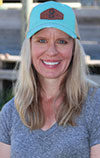I have not traveled from coast to coast yet, but our family came pretty close.
We had the opportunity to travel to see new country and a few friends along the way. We live in Montana, a state known for its big skies and open spaces. There is much to love here. In fact, many people claim there is no better place to live. I’ve heard others say their state is the best as well. I love hearing why others enjoy where they live. A person should like where they live.
I have lived in Montana most of my life; a few years were spent in Idaho. While I haven’t lived in a plethora of places, I have learned to look for the beauty in every place. Deserts, mountains, plains … they all have something to offer.
When we were driving, I loved watching the contour of the land. The change in elevations, the switch from mountains to prairie, the weather – all of it brought depth to my perspective. Sometimes when we hear of other people’s experiences, we visualize them in our own surroundings, making them familiar to us. That isn’t bad, per se, but when we can put ourselves in someone else’s shoes and in their environment, it brings a greater experience. It makes the world a bit bigger.
- I can now picture wind and tornadoes rolling through fields in Iowa.
- I’ve plucked the green grass of Missouri – in August. (Montana has been on fire in August for many of our recent summers.)
- The Ozarks and the mountains of Arkansas protruded their beauty. I had no idea other states had mountains. (Just kidding.)
- I stood next to peach trees in Colorado.
- I traveled the plains of northern Texas. And the plains of northern Texas. And the plains of northern Texas. It was a repetitive beauty.
- I saw watermelons for sale at a roadside stand in Oklahoma.
Traveling opens our eyes to the value of diversity. I know diversity is a buzzword in our culture for other reasons, but valuing the diversity of land and the differences in production based on location is important. We can’t all do things the exact same way.
My friends in Missouri have never seen the ice that gathers on wheel lines and pivots in Montana. The irrigation water gets turned on in April here, but the freezing doesn’t stop until late May, often June. We choose to wait until June to turn our irrigation on, but everyone does things the way they feel is best.
We talked to producers in several states about how they put up hay, graze cattle and keep water clean. It feels a bit like having family all over the U.S.
As we traveled, we talked about land in terms of agriculture. In fact, traveling with those whose lives are immersed in agriculture sounds something like this:
- “Cows will eat seaweed.”
- “I wonder how much seaweed they’d actually eat?”
Nearly everything is looked at in relation to cows. Land is valued by how many cows you can raise per acre.
The views are crucial:
- “How does the grass look?”
- “What kind of grass is it?”
- “What is the available water source?”
Food choices on the road supported the agriculture industry. Comments included the following:
- “Our horses would need different shoes for this country.”
- “People wear cowboy boots here.”
- “What in the world is that?”
Beauty is always appreciated:
- “Wow, look at those tires.”
- “That’s a brand-new tractor.”
- “Check out how tight that fence is.”
- “Did you see the leather work on that saddle?”
The other thing we noticed was the dirt. The red clay, the rich black soil, the sandy loam all provoke discussions about what will grow and what won’t.
Throughout our trip, I found myself wondering, “What deposits have been made to this land? What deposits does it still need? Is there abundance or a lack?”
Later though, I realized that this thinking is top-down and not bottom-up. Meaning, what are we going to do with the land as producers versus what does the land want to do for us? I think both are important questions. We must listen to the land to discover what it wants to tell us while also thinking about how we can make contributions to the land to improve it.
I realize no place is completely perfect, but if you have a community you fit into, well, that is a gift. And sometimes traveling to see what else is “out there,” outside of our little circle, helps us have a greater perspective and worldview. Being a part of agriculture is a blessing, but it is also a lot of hard work.
Seeing pastures across the fence from yours – and maybe across state lines – may bring clarity on what we are pursuing on our own place. At the very least, it connects neighbors and friends while expanding our options.









